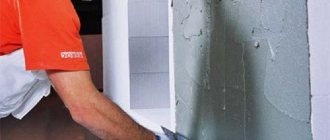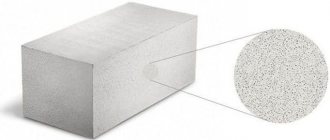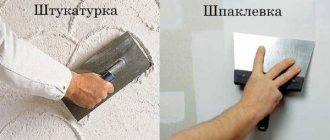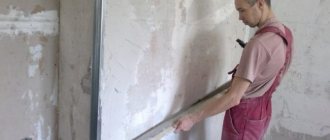Oriented strand boards (OSB, OSB or OSB), invented in Canada during the era of mass construction of frame residential buildings, have also become interested in Russia. Lightweight, fairly durable slabs are used both for cladding facades and for interior decoration. It is quite understandable that they are trying to improve the nondescript surface of glued wood chips with decorative materials. One of the popular ways to achieve this is by applying protective plaster over an OSB board on the facade of your house.
Is it possible to plaster OSB
Having decided to clad the façade of their house with OSB or use particle boards indoors, homeowners carefully consider their finishing options. At the same time, the question of whether it is possible to plaster an OSB board is the first to arise in most cases. After all, if you neglect decorativeness and leave OSB without an external coating (especially on the facade), then even wood coated with water-repellent compounds will absorb moisture.
This water is enough to swell the slab in summer and defrost in winter. The OSB will darken, warp and lose its strength. In addition, a serious disadvantage of OSB is the chemical component of the binder, which is why the boards must be protected from temperatures above +30°C. Therefore, from the moment the production of slabs began, builders began to think about a protective coating for them.
The most commonly used types of finishes are:
- painting (the cheapest and easiest option);
- wallpapering (suitable only indoors);
- cladding with decorative panels attached directly to the slabs (a rather expensive method that does not solve all the problems of preserving smallpox);
- covering with siding (does not eliminate the problem of flammability of slabs, requires additional measures for vapor barrier of OSB);
- tiling (suitable for indoors, but “blocks oxygen” to wood);
- facing slabs with a coating of decorative stone (the most expensive and time-consuming method);
- plastering.
Types of finishes for OSB boards
Properties that a protective coating for OSB should have:
- waterproof and waterproof;
- sufficient mechanical strength;
- temperature stability (withstand sudden changes);
- vapor permeability;
- environmental friendliness;
- fire safety;
- long service life;
- maintainability;
- unattractive to mold, mildew and rodents;
- resistance to solar radiation;
- light weight;
- affordable price;
- simple operation without extra costs;
- opportunity to do it yourself.
What can be used
There are compositions that are specially designed for plastering OSB boards, although they are rarely found on sale. Most funds are considered universal and are divided according to other principles.
For example, according to the properties and specific application of plaster there are:
- leveling;
- finishing;
- special: noise-reducing, waterproofing, etc.
Usually finishing plasters are chosen for cladding, because the slabs do not need leveling. Plastering products are sold ready-made or require dilution with liquid. In addition, building mixtures can have different compositions: some are suitable only for outdoor work, others for indoor work, and others are used in any conditions. The difference in quality and function is provided by the plaster base, as well as fillers and additives.
Polymer compositions
Plasters with polymer binders are a material ideal for processing OSB. They are based on synthetic resins or other polymers that provide high strength and long service life.
The most popular materials in the group are:
- Silicone plaster. It is very plastic, easy to lay on the surface, resistant to moisture, and at the same time vapor permeable. Has antiseptic properties. Available in white and pigmented versions.
- Silicate plaster. Contains liquid glass, which after hardening provides the coating with special strength. The plaster is not afraid of water, does not disturb the microclimate in the room, and helps to destroy fungus. The service life of the material is 30–50 years, but its price is quite high.
- Acrylic plaster. Made on the basis of acrylic resin, suitable for interior use only. It has less high strength than other representatives of polymer compositions. It can be easily tinted or painted after hardening and is inexpensive.
- Siloxane plaster. It is a modification of a silicone mixture based on siloxane - silicone with a simplified molecule. It has less pronounced moisture resistance than silicone and is gradually destroyed by ultraviolet radiation. The service life of such plasters is 3–5 years.
- Polymer cement plaster. This is an improved cement-sand mixture enriched with polymers. Due to changes in composition, the material becomes elastic, gains greater bending strength, shrinkage, and gains excellent adhesion to building materials and abrasion resistance.
To treat OSB indoors, you need to buy only environmentally friendly water-based compounds. For facade work, plasters based on organic solvents are more suitable, since their strength and moisture resistance will be higher.
Decorative plasters
Materials of this group are intended not only for protection, but also for creating a decorative layer on OSB boards. They are suitable for external and internal use and contain various fillers. The main types of decorative plasters that can be used when working with oriented strand boards:
- Structural. Includes impurities of quartz and small stones. When applied to a base, it produces a rough surface. When facing OSB with some types of structural plasters, multi-colored spots appear.
- Venetian. Contains fine marble chips. After drying, the base will resemble stone, which looks noble and very beautiful.
- Textured. They may contain a wide variety of impurities: cellulose, pebbles, mica, silk, pieces of fabric.
- Flock. They consist of three layers: base, flock (with pieces of dried acrylic) and varnish. They are quite expensive and difficult to use.
Mineral plaster
The basis of such plasters are cement, gypsum, lime, clay. In their pure form, they are not suitable for working with OBS, since they do not have the proper ductility and are afraid of impact. If you accidentally hit the wall, a whole piece of plaster may fall off the slab. When the building vibrates, the layer can also crack. Gypsum mixtures are very sensitive to moisture and are not suitable for outdoor work or wet rooms. The advantages of mineral plasters are:
- vapor permeability;
- environmental friendliness;
- strength (under static loads);
- frost resistance;
- maintainability;
- durability;
- affordable price.
Why do OSB panels need to be plastered?
Plaster has all of the above properties.
Plaster coating also:
- serves as additional heat and sound insulation;
- forms a monolithic coating that hides seams and surface defects;
- can give the building a unique look.
Therefore, private owners actively use OSB plaster on the facade and for interior decoration.
Having correctly plastered the wood chip slabs once, they forget about repairs for a long time. And if you get tired of the appearance, you can easily change it by painting it in new colors. This coating is easy to clean, reliable, and does not allow drafts.
What tools will you need?
Regardless of whether putty will be used for OSB boards for painting, before gluing wallpaper or finishing in another way, prepare:
- sandpaper of different grain sizes;
- serpyanka;
- rubber spatula;
- wide spatula;
- roller, brush;
- roulette;
- container for mixing components (if dry mass is purchased);
- construction mixer.
What plaster is used for OSB boards
If plaster is the finishing touch to the “layer cake” - a composite coating of OSB, then, as a rule, there are no particularly difficult problems with the choice of plaster composition. Therefore, speaking about plasters, we will touch upon conventional compositions based on various binders. In addition, there are compositions specifically designed for plastering OSB.
Layer cake pattern
Using polystyrene foam to insulate wooden structures is possible but not advisable!
Plaster mixtures are divided into types:
- leveling (roughing);
- decorative (finishing);
- special (thermal insulation, X-ray protection, noise reduction, waterproofing, etc.)
Safety precautions
How to plaster a wall correctly, beautifully and without causing harm to health? To do this, you need to follow simple requirements:
- You should only work in special clothing and shoes; you can use old things, as long as the material is dense enough and breathable.
- A hat is also required; if plastic material gets on your hair, it will be difficult to wash it out.
- Gloves should be worn on your hands, although many people do not want to use them. The effect of plaster makes the skin very dry, and more than one tube of cream will be needed to soften it. Bare hands are more susceptible to injury than those covered with gloves.
- Do not neglect safety glasses, because even minor splashes in the eyes can spoil the impression of the repair.
- In any case, you will have to use scaffolding, for example, a chair, table or ladder. It is impossible to carry out work directly applying plaster from a ladder, as horizontal force is applied and there is a risk of falling.
It is important that the scaffold stands firmly on the floor or other foundation. If you feel dizzy or feel unwell, it is better to take a break and not get up to heights. Own safety is in the hands of the owner himself.
Recommendations from finishing specialists (2 videos)
Various plaster mixtures (20 photos)
Methods for plastering OSB boards
When applying the plaster layer, the following problems may occur:
- absorption of moisture from the solution by wood;
- the formation of cracks in the plaster coating due to the “play” of wood when moistened;
- difficulties in ensuring reliable adhesion.
These problems are solved in various ways. There are two main methods of plastering OSB:
- without insulation;
- with insulation.
In both cases, OSB boards must be firmly fixed to the wall to prevent significant movement during work and during shrinkage.
Traditional way
Information on how to plaster oriented strand sheet material without insulation is provided as an extreme option, which it is advisable to avoid. A plaster coating without insulation can cause a lot of trouble for the property owner during operation.
Preparatory work
When preparing for work, it is necessary to analyze how the sheets, that is, the basics, will be fastened. This must be strictly carried out in accordance with the requirements of building regulations, and it is not recommended to independently reduce or increase the number of elements.
OSB boards must be fastened firmly enough to prevent them from moving. The presence of vibration and mobility of the base are the main negative factors affecting any structure. It is important to know that the use of additional fasteners to strengthen the structure cannot be used.
OSB is sheets made from wood chips. By themselves, they absorb water, and the plaster marking is rejected. Without preparation, the surface will become covered with a network of cracks, and the solution will gradually peel off. Creating a special insulating overlap between the slab and the covering layer will help avoid this problem.
There are 2 options for insulating coating:
- Fastening the insulation.
- Upholstering the surface with kraft paper or cardboard impregnated with bitumen.
Features of plastering indoors and on the façade of a building
In addition to the fact that the plastering materials used and plastering of OSB boards, performed indoors, differ from plastering outdoors in working conditions. During facade plastering work, select several days of dry, windless, warm weather. The workplace is covered with a canopy from the sun and unexpected rain. The air temperature should be above +5, but not more than +35°C.
Indoor conditions are more comfortable. Humidity (no more than 65%) and the absence of drafts are of great importance here. Fans and heaters cannot be used to speed up the drying process of plaster solutions. Violation of the conditions will lead to the appearance of cracks. Before plastering, de-energize the electrical wiring.
Applying putty
Finishing OSB walls with putty is allowed only at positive temperatures and at air humidity of no more than 60%. If this rule is not followed, the plaster layer will subsequently quickly crack and fall off.
OSB walls are usually puttied in two layers. The material is applied to the slabs and carefully leveled horizontally. First use a spatula and then a rubber roller. Next, a little more putty is applied to the wall and leveled, this time in a vertical direction.
After all surfaces are finished, a second technological break is arranged. The drying time of the putty layer before painting or applying wallpaper depends on the type of composition used. But most often the final finishing of the walls begins no earlier than a day later.
Before painting or wallpapering, putty walls are cleaned with fine sandpaper. For this purpose, you can, of course, use the paper itself. But it’s better to purchase a special paint grater. This tool is inexpensive and can save a home craftsman a lot of effort.
OSB surface preparation
OS boards may be dusty and dirty. It is necessary to sand the surface, remove dust and dirt stains. Since wood material cannot be washed, special products containing organic solvents, such as white spirit, are used for cleaning. The seams are sealed (the sealant for OSB is elastic, since the slab must have an expansion gap on the sides), primed and puttied to obtain a flat surface.
Sealing seams between slabs with sealant
Puttying technology - process sequence
The work is not particularly complicated and repeats all operations applied to other surfaces. Theory alone is not enough to cope with the finishing of capricious materials. For those who have some experience in puttying, it is useful to familiarize yourself with the video material, which will tell you about the features of working with OSB.
Operations are carried out in the proposed sequence to avoid mistakes and not miss anything. Begin by sanding the surface, joints and ends with fine-grained sandpaper. Remove dust and be sure to prime. After treatment with the compounds, a protective film is created that prevents resins and other substances from reacting with the finishing material.
Sealing joints at the beginning of work
After the last, third layer has dried, puttying begins. The work is carried out at a temperature of +1° or more and in relatively dry air in which dampness is not felt. The composition is placed on a tray and applied to the slabs with a spatula. After treating a small area, level the coating and remove excess. This is done until the putty has set.
Tools of different widths are used. Using a narrow spatula, spread the composition over a large area. Holding it at an angle to the surface, smooth the mixture evenly. The next portion should overlap the previous one without too noticeable transitions. A layer of more than 2 mm is not allowed: this is not only a waste of material, but also a risk of cracking. The putty is allowed to dry for 3–12 hours depending on humidity and temperature.
Then the surface is polished, eliminating irregularities. If noticeable depressions remain, correct by applying the composition and repeat the previous operations. When an acceptable result is achieved, it is painted or wallpapered. Sometimes reinforcement with non-woven fabric is required. The individual pieces are overlapped, then the joints are cut and the excess is removed.
Installation of insulation
The material used for external insulation of OSB sheets is polystyrene foam boards, which have sufficient strength and are completely moisture-proof. The lightness of polystyrene foam insulation allows it to be installed on an adhesive basis, which in this case is the only available option.
In general terms, the installation process looks like this:
- The sheets should be cleaned of dust, they should not be wet or greasy - if necessary, the sheathing should be treated with white alcohol to degrease the surface
. Oil stains, large amounts of dust or dirt can significantly reduce the degree of adhesion of insulation to OSB sheets; - Apply the adhesive composition to the insulation using a calibration spatula so that the glue covers the entire surface of the sheet. How to make decorative sculpture on a wall using putty? Then the sheet is pressed against the sheathing - in order for the glue to fill the voids, you need to lightly press on the insulation. After the entire structure is covered with insulation, you must wait until the glue has completely dried and only then proceed to the next stage;
- Reinforcement is installed on the insulation in the form of a plastic or fiberglass mesh with 6x6 mm cells - they have a self-adhesive base and you will not have any problems with installation.
Upholstery
First of all, the joints between the sheets are coated with an elastic sealant, after which the surface is covered with kraft paper or bitumen cardboard, which is fixed with a stapler. Reinforcement in the form of a fiberglass or plastic mesh is glued onto the surface prepared in this way, after which the walls are ready for applying plaster mortar.
The undoubted advantage of this method is the cost-effectiveness of the process, however, the lack of insulation will negatively affect the thermal insulation characteristics of the building. This disadvantage can be partially compensated for by internal insulation.











